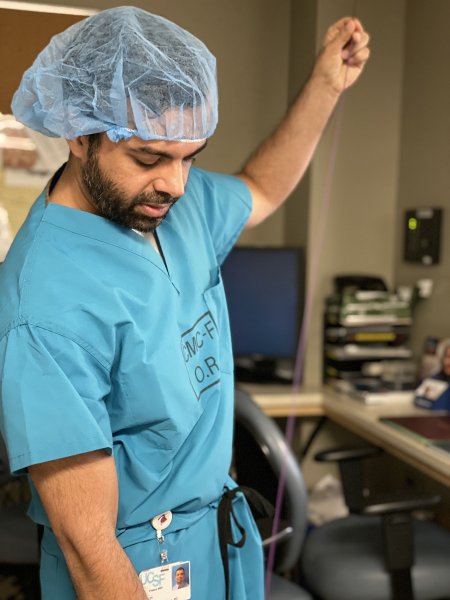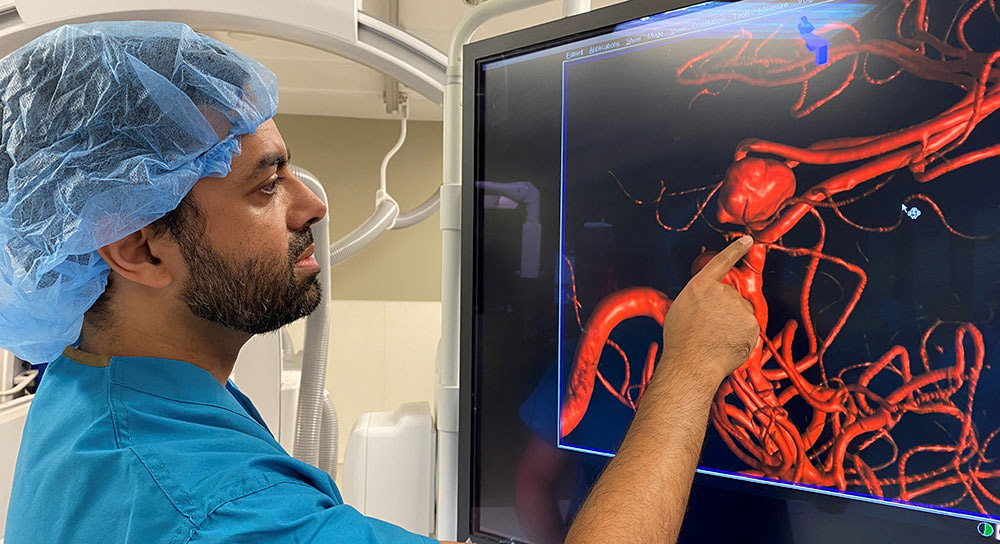“I had this massive headache and all of a sudden I felt awful,” Garcia said. “I decided to drive home and it started getting even worse … like my head was going to explode.”
That’s when she pulled over and punched 9-1-1 into the phone, but didn’t push send until she was in her driveway.
“I remember the ambulance coming, but from there on I don’t remember hardly anything — just bits and pieces,” she says.
That phone call saved Garcia from likely loss of brain function from what turned out to be a ruptured blood vessel. Lucky for her she was transported in time to Community Regional Medical Center, the only hospital in the Central Valley that treats brain aneurysms. Knowing the signs of this life-threatening condition can help you get to the hospital faster.
Knowing aneurysm symptoms can save your brain
Dr. Amir Khan, director of Neuroendovascular Services and co-director of the Community Regional Medical Center Stroke Program, says what Garcia experienced is what most people describe when they have a brain aneurysm.
“We tend to say it’s a headache that’s the worst you’ve had in your life, and it starts very suddenly and often times is accompanied by nausea or other signs of stroke,” he says. “That person might also have difficulty with their ability to move, speak, understand things, or have problems with their vision.”
Dr. Khan met Garcia that Christmas Eve seven years ago in Community Regional’s emergency department after she was transferred there from another local hospital.
“She came in with a cerebral aneurysm and was very confused,” he says. “And we were fortunately able to take her to the operating room and treat her rupture.”
Endovascular treatment of a ruptured brain aneurysm
Dr. Khan did a cerebral (or brain) angiogram followed by repair of Garcia’s ruptured brain aneurysm.
“That's the process of going into the arteries in the brain and visualizing them in good detail to show us the anatomy,” he says. “I see exactly what the issue is … where the problem is and where the aneurysm is located, which gives us information how to treat it.”
 By using the angiogram as a guide, Dr. Khan then uses a coil or multiple coils that he inserts inside the vein to stop the bleeding, restore normal blood flow and repair narrowed vessels.
By using the angiogram as a guide, Dr. Khan then uses a coil or multiple coils that he inserts inside the vein to stop the bleeding, restore normal blood flow and repair narrowed vessels.
Dr. Khan’s colleague, Dr. R. Loch MacDonald, a UCSF clinical professor of neurosurgery at Community Regional, provides an analogy of how an aneurysm ruptures.
“So if you imagine a hose in your yard and it gets a weak spot and then bulges out, that would be like an aneurysm in your brain,” he says. “And then if the hose ruptures, water comes out in your yard. That’s what happens in your brain when an aneurysm ruptures.”
Time makes a difference in saving brain function
Dr. MacDonald says Garcia did the right thing when she called 9-1-1.
“But the key thing that you need to know is that if you have a sudden, severe headache — worse than you've ever had — that's a warning sign, and you need to get to the hospital as soon as you can,” he says.
The bleeding into the brain can cause a wide spectrum of problems, including permanent brain damage or even death. Diagnosing and treating as soon as possible increases the chance of a better recovery according to the National Institute of Neurological Disorders and Stroke.
From Bass Lake, Garcia went by ambulance to a local hospital and then was transferred to Community Regional downtown because it’s the only hospital in the Valley that provides the highest level of care for cases like Garcia’s.
“You know, I don’t remember much at that time,” Garcia says about when she was brought to the first hospital. “They did an MRI and checked me. I heard them say, ‘Oh yeah, she’s having an aneurysm.’”
The next thing she knew, she was at Community Regional.
“I’m very grateful, very grateful for Dr. Khan as well,” Garcia says. “I didn't realize at the time that Community Regional was so vital to the area because I'd never really been there, to be honest with you. I would tell anybody to go there.”
“The fact that she came in early allowed us to give her treatment to prevent further complications that could happen even in the early phase,” said Dr. Khan.
Dr. MacDonald also says studies indicated patients getting to the hospital quickly had better outcomes.
Aneurysms can run in families and occur more than once
Garcia, a now-retired Madera school teacher, says Dr. Khan also found two other aneurysms at the time he was treating her.
“So aneurysms can have a familial or family-inherited component to them,” Dr. Khan says. “It is important that if someone has a family history of someone very close to them who's had a brain aneurysm — and when I say close, I mean either parents, children or siblings — they may be at an increased risk of this happening.”
He says in some cases he recommends screening people who are that close in relation to the person who's had a ruptured aneurysm. He stresses that's only done when there's at least two people very close to you who've had brain aneurysms.
“I'm happy to say her prognosis is excellent. Statistically we know that people who've had one ruptured aneurysm are at risk of another ruptured aneurysm,” he says. “In Publita’s case, we were able to identify those other aneurysms and treat them.”
Over the last seven years, Dr. Khan has continued to monitor her arteries and none of her recent images shows any other areas of concern.
“And so I think in her case, it would be quite rare that she would ever have another one,” he says.
And Garcia is grateful for the reassurance over the years because, in the beginning, even a normal headache would make her panic.
“I would get headaches and I would panic, you know. So I would call Dr. Khan's office, and I think it was really cool he would reassure me each time,” Garcia says. “That would settle me down until finally I realized that people do have normal headaches.”
Garcia has since retired from teaching fifth grade in Madera, but reminisced how quickly she was able to return to normal life back then. And she attributes it to her caregivers and having had timely, high-level care near home.
“I went back to work in four months,” Garcia states proudly of her recovery. “They told me it might be a year and a half at least — but it wasn’t!”





